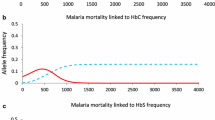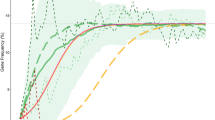Abstract
Because of the relative prevalence of hereditary sickle cell disease and the auxiliary role of the sickle cell gene in reducing the mortality of malaria, it is believed that P. falciparum has exerted selection pressure on human populations to increase the prevalence of this otherwise detrimental gene. A model incorporating three genotypes and two age cohorts is used to test the hypothesis that higher death rates due to malaria can exert selective pressure to increase the prevalence of the sickle cell gene. The model displays selection pressure for the carrier gene in the presence of increasing malaria death rates for either adults or children, showing both higher final frequencies of the gene as well as shortened time to reach these frequencies.





Similar content being viewed by others
Notes
Population Reference Bureau, retrieved August 31, 2010 from http://www.prb.org/Datafinder/Topic/Bar.aspx?sort=v&order=d&variable=85.
CIA online factbook, retrieved August 31, 2010 from https://www.cia.gov/library/publications/the-world-factbook/fields/2066.html.
References
Aidoo M, Terlouw DJ, Kolczak MS, McElroy PD, ter Kuile FO, Kariuki S, Nahlen BL, Lal AA, Udhayakumar V (2002) Protective effects of the sickle cell gene against malaria morbidity and mortality. Lancet 359:1311–1312
Allison AC (1954) The distribution of the sickle-cell trait in East Africa and elsewhere and its apparent relationship to the incidence of subtertian malaria. Trans R Soc Trop Med Hyg 48(4):312–318
Aluoch JR (1997) Higher resistance to Plasmodium falciparum infection in patients with homozygous sickle cell disease in western Kenya. Trop Med Int Health 2(6):568–571
Bremen JG (2001) The ears of the hippopotamus: manifestations, determinants and estimates of the malaria burden. Am J Trop Med Hyg 64:1–11
Gallup JL, Sachs JD (2001) The economic burden of Malaria. Am J Trop Med Hyg 64:85–96
Hesran JY, Personne I, Personne P, Fievet N, Dubois B, Beyemé M, Boudin C, Cot M, Deloron P (1999) Longitudinal study of Plasmodium falciparum infection and immune responses in infants with or without the sickle cell trait. Int J Epidemiol 28:793–798
Irizarry K, Fish M, Madigan D, Taub J (2008) Shelter from the Swarm: the Malaria-Sickle cell connection. Dartm Undergrad J Sci 4:28–32
Luzzato L (1970) Increased sickling of parasitised erythrocytes as mechanism of resistance against malaria in the sickle cell trait. Lancet 295(7642):319–22
Makani J, Komba AN, Cox SE, Oruo J, Mwamtemi K, Kitundu J, Magesa P, Rwezaula S, Meda E, Mgaya J, Pallangyo K, Okiro E, Muturi D, Newton CR, Fegan G, Marsh K, Williams TN (2010) Malaria in patients with sickle cell anemia: burden, risk factors, and outcome at the outpatient clinic and during hospitalization. Blood 115(2):215–220
Nagel R, Roth EF (1989) Malaria and red cell genetic defects. Blood 74:1213–21
Rowe AK, Rowe SY, Snow RW, Korenromp EL, Armstrong Schellenberg JR, Stein C, Steketee RW (2006) The burden of malaria mortality among African children in the year 2000. Int J Epidemiol 35:691–704
World Bank (2006) Disease and mortality in Sub-Saharan Africa. World Bank Publications, Washington, DC
Author information
Authors and Affiliations
Corresponding author
Rights and permissions
About this article
Cite this article
Liddell, C., Owusu-Brackett, N. & Wallace, D. A Mathematical Model of Sickle Cell Genome Frequency in Response to Selective Pressure from Malaria. Bull Math Biol 76, 2292–2305 (2014). https://doi.org/10.1007/s11538-014-9993-z
Received:
Accepted:
Published:
Issue Date:
DOI: https://doi.org/10.1007/s11538-014-9993-z




